By Siti Maimunah and Sarah Agustiorini
Increasing pressures from extractive industries on the Mahakam River in Kalimantan, the second largest river in Indonesia, risk an irreparable destruction of a commons. Yet residents are actively organizing to reclaim the river as a common living space, as Siti Maimunah and Sarah Agustiorini illustrate in this new post of the series “Reimagining, remembering, and reclaiming water: from extractivism to commoning”.
Imagine we had a time machine, so we could experience the past of the Mahakam River, the second longest river in Indonesia, which flows through the province of East Kalimantan. We could see the old oil and coal mine companies operating from 1896 till 1899 and the Dutch and Japanese timber companies in the 1920s. Old iron woods would drift along the Mahakam River heading to Makassar and Singapore before being shipped to China or Europe.
Fast forward, half a century later, to the same place, and little has changed. Rafts made of logs travel along the Mahakam for kilometres towards processing plants located on the banks of the river. Lines of barges carry these iron woods from pristine forests and ship them to Japan and Europe. Every day, on the same river, we can see 60 to 80 colourful barges transporting piles of coal. Each barge transports about 7 to 8 thousand metric tons of coal to the power plants in Java and Bali, or even to India, China and other Southeast Asian countries.
Through these uses and the associated pollution, for over a hundred years , the Mahakam River and its surrounding ecosystems have been going through several processes of privatization to benefit the extractive industry.
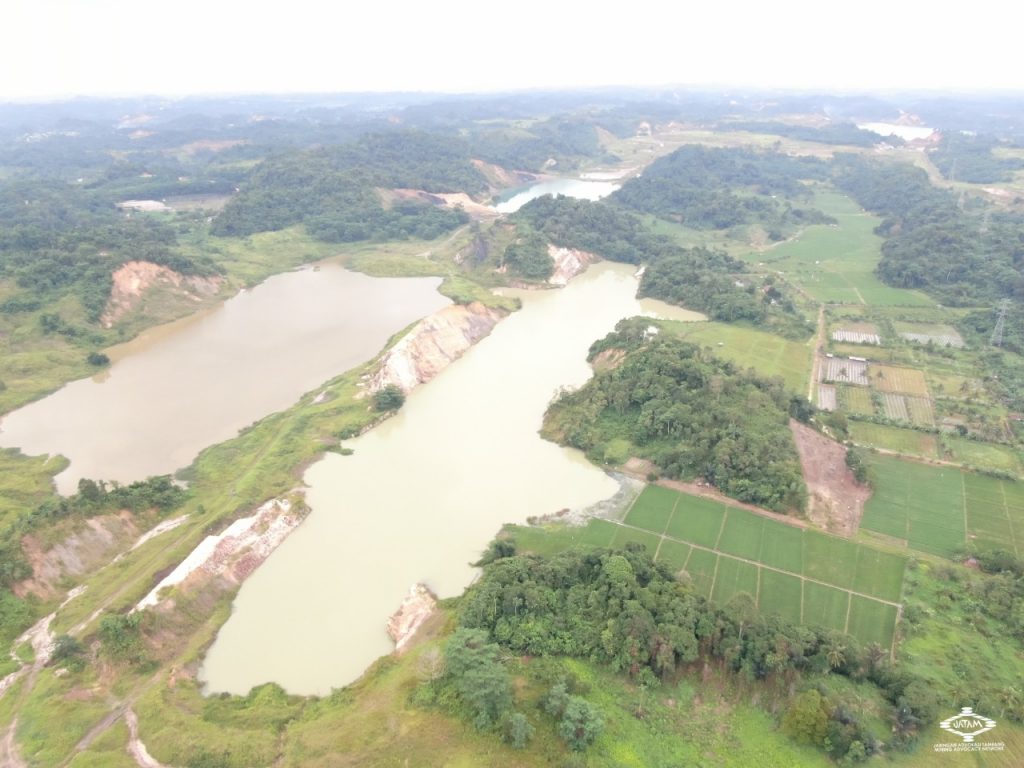
The abandoned coal mine pits in the middle of the Makroman village in Samarinda city. Photo: Senny Jatam.
Rivers as a common living space
We understand rivers, just like karsts, forests, the sea and other ecosystems, as common living spaces or “commons” supporting the reproduction of life. This means that rivers should not be owned by any individual, nor should they be privatised. The reciprocal relationship between nature and society in the commons produces knowledge and experience, cooperation and dependence; though the forms of this co-constitution vary in different times and places.
The Mahakam river is home to a diversity of non-human natures, including 298 species of birds, 70 of them protected and 5 endemic; and 147 species of freshwater fish, including some endemic ones that migrate upstream every year. It is also the last resort for the ‘pesut’, an endangered freshwater dolphin (Orcaella brevirostri), of which only 80 specimens remain.
The river has witnessed the rise and fall of the Hindu Kutai empire (350-400 AD) and of the Islamic Kutai Kartanegara kingdom (1300 – 1945). It has been a trading route and the place where Islam started to be spread in East Kalimantan since 1565. The close relationship between the river and its people is celebrated every year with a festival called Erau, a celebration of gratitude for the products of the earth. The festival has taken place since the 12th century and it is usually celebrated for 40 days, ending with the belimbur ritual, a bathing or cleansing in the river.
Samarinda, the city through which the Mahakam River flows, has grown into a trading port city since the 1700s. It was crowned as the capital of East Kalimantan in 1959 and it extends for 71,800 hectares. Samarinda grew hand in hand with the extraction industry and has ‘allured’ many foreigners and neighbouring people. The Indonesian transmigration program and independent migration from Java and surrounding areas started just after independence from the Dutch colonial empire in 1945. Back then, migrants started to become cheap labour for the extractive industries in East Kalimantan, and they still are. In 2019, the population density of Samarinda was the highest in the province.
The multiple layers of privatization on the Mahakam River
The body of the Mahakam river has been fragmented into different administrative areas, which consist of three districts and one city. The upstream of the Mahakam Riveris located in the Mahakam Ulu and West Kutai district; it then flows through the Kutai Kartanegara District and then through Samarinda City. Different parts of this river body have been mapped, monetized and assigned different extractive purposes: logging, conservation, industrial land, settlement, and many others. Peluso and Vandergeest call this process “territorialization”, to indicate how the State engages in the making of regulations, maps, legal institutions, administrative borders, concessions and infrastructures in order to organize its territory.
The territorialisation of East Kalimantan –meaning its spatial privatization through concessions to gas, coal, mining, and timber industries– can be traced back to the colonial days. Yet it has grown massively and systematically since Indonesia’s independence, and especially since 1965, under the authoritarian government of Suharto (Soeharto). Alongside the gas and mining industry, logging activities became the main income source for the Suharto regime and his cronies until his regime’s fall in 1998.
Since 1968, around 17 companies have been given logging concessions in the upstream of the Mahakam River, or the right to occupy and extract hundreds of thousands hectares of forests. Logging companies have transformed the Mahakam River banks into a log-pond and transportation route line to deliver the logs out of Samarinda, while privatizing and destroying the region’s forests. From 2009 to 2013, the Mahakam watershed lost 128 thousand hectares of its natural forest due to wood extraction, mining, and wide scale plantations.
Forests were continuously cut down and only partly renovated until they were unable to fulfil the demand of timber processing machines. In 2008, and again in 2014, Indonesia was declared as the country with the highest deforestation rate in the world. Meanwhile, the increase in world’s coal demand fostered more spatial privatisation through mining concessions and coal exploitation. Since the 2000s, an increasing number of mining permits has been granted, especially around the times of the national and local elections. As a regulation tool, permits become a source of money and votes for politicians. As of 2016, 748 mining concessions around the Mahakam River had been granted. These concessions also include parts of the riverbed and its water, as is the case of 3 concessions in Samarinda. The conveyors and coal stockpiles as well as the barges and boats fill the river transporting the coal out of East Kalimantan. In other words, the river´s socio-ecological infrastructures have been transformed into an extraction infrastructure.
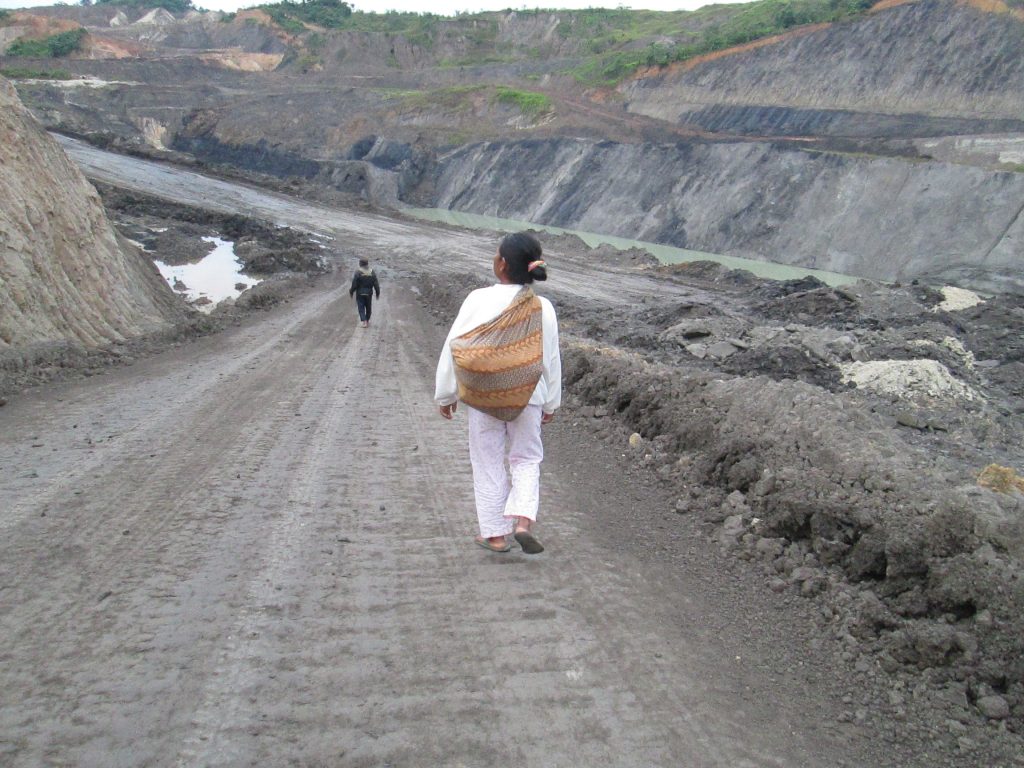
Rice fields have been transformed into coal mines. Farmers walk in-between mine pits at Makroman Village, Samarinda. Photo: Siti Maimunah.
The ‘residual spaces’ of Samarinda
Historically, Samarinda residents are a mix of indigenous people of Dayak, descents of families from other Kalimantan areas, neighbouring islands such as Sulawesi, Sumatra and Java, who came as war refugees before Indonesia’s independence, or as displaced people due to poverty floods and other social and environmental calamities. They moved to Samarinda with the hope of having a better future, working as formal or informal labourers in the timber industry along the Mahakam river. The living space along the Mahakam River was transformed into a city’s refugee pouch that serves the extraction industry. Not much space is left for the city’s population: people are settling in the city’s corners, the “residual space”, that was maybe planned, maybe abandoned. Some areas with unscripted plans have weak ownership rights, and possibly could be evicted at any time.
The transformation of the river and its watershed from a commons into a privatized space has affected the residents of Samarinda. The fisherfolk have difficulties working in the river since the timber and mining companies occupying the river bed for their infrastructure have increased the river’s sedimentation. The local newspaper recently reported mass deaths of the river’s fish. Some of the fisherfolk who cultivate river fish in floating ponds (karamba) also face difficulties from the coal transportation vessels, which often impact and damage these ponds.
Additionally, the deforestation and soil erosion first from the logging industry and now from the coal industry’s digging of the soil, have caused substantial erosion and sedimentation of the river, leading to a dramatic increase in flooding. From November 2008 to June 2020, floods have inundated almost every corner of the city, covering the main roads and interrupting economic activities, including public transportation and markets. About 50.000 people have been affected by 5-6 major floods every year.
However, the government keeps blaming the slum areas. In 2008, they announced that the settlement along the Karang Mumus riverbanks will be demolished in order to reduce flooding and rearrange the settlement area.
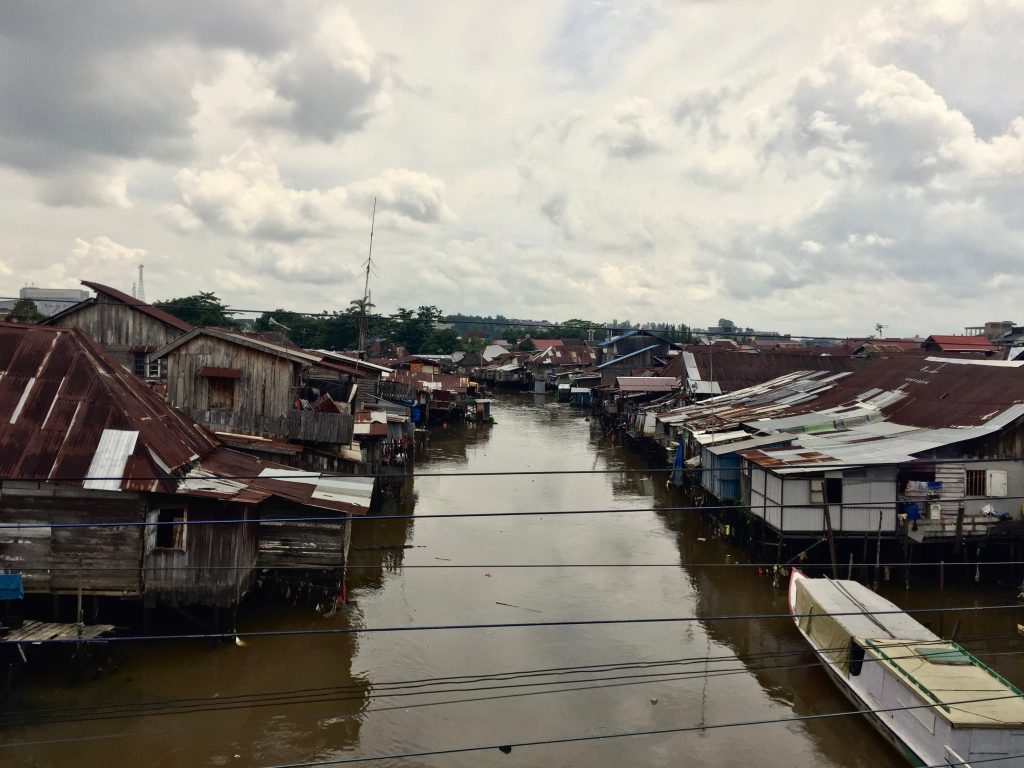
Belibis resident, on the river bank of Karang Mumus, one of the slums on the river bank in Samarinda. Photo: Sarah Agustiorini.
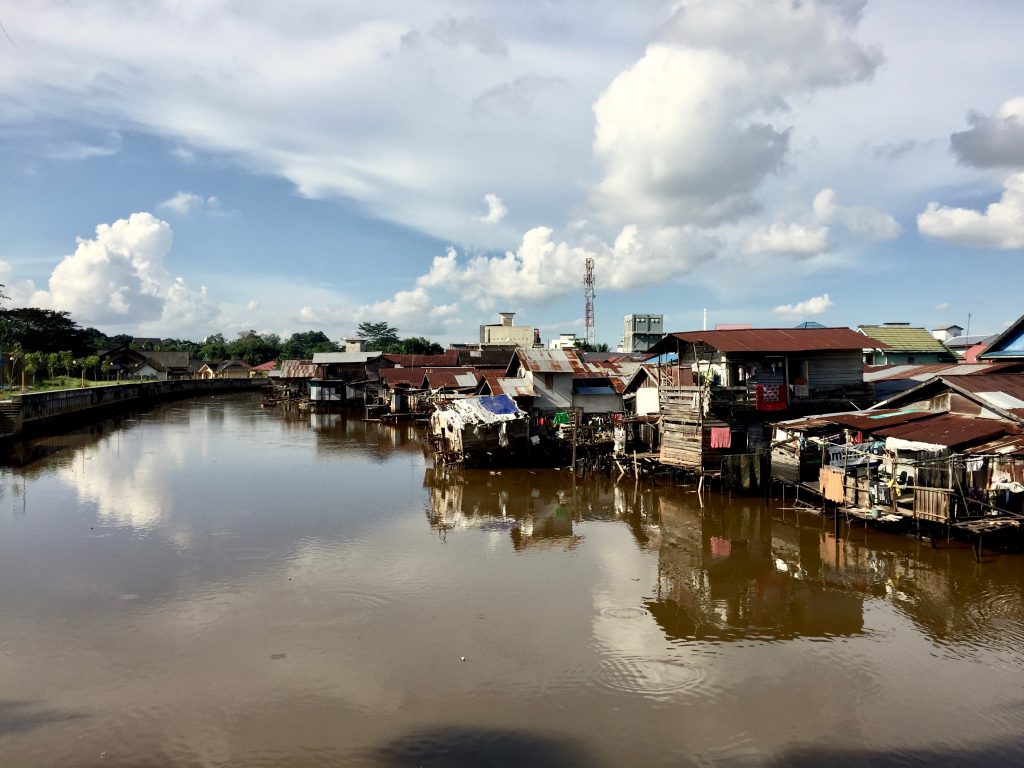
Ruhuy Rahayu residents on the river bank of Karang Mumus, another slum on the river bank in Samarinda. Photo: Sarah Sarah Agustiorini.
Privatizing drinking water
In these residual spaces, the state presence is evident through the privatization of water by the state water company Perusahaan Daerah Air Minum (PDAM) 45 years ago. Since then, the quality of the water has declined significantly. According to an investigation carried out from 2009 to 2011 by the East Kalimantan Environmental Agency, the river is heavily polluted. One of the main issues has been the sediment deposits caused by the extractive industry. Despite the complaints by customers because of the slow water pressure, turbid water, and unstable supply, PDAM’s profit has been enormous.
The RASI foundation, a conservation organization concerned with the preservation of ‘Pesut’ (river dolphins), found an exceeding amount of cadmium and lead in the Mahakam river during 2017-2018. The PDAM responded to this situation by increasing the usage of water purifier chemicals such as calcium hypochlorite, sodium carbonate, aluminium, sulphate, chlorine and kaolin. If consumed continuously, these chemicals are carcinogenic.
PDAM does not serve the highland areas of Samarinda such as Palaran, North Samarinda, and Sambutan sub-districts where around 28% of the city’s population lives. There, the water catchment area has been changed due to mining concessions. Moreover, there are 394 abandoned coal mine pits without restoration. Given this scenario, people have three options: they can consume water from the abandoned mine pits, they can build their own wells or buy water gallons and water tanks. The first option would mean drinking polluted water, but the other two are costly. Digging a well can cost between 175-295 euro, while the monthly minimum wage in Samarinda is about 185 euro.
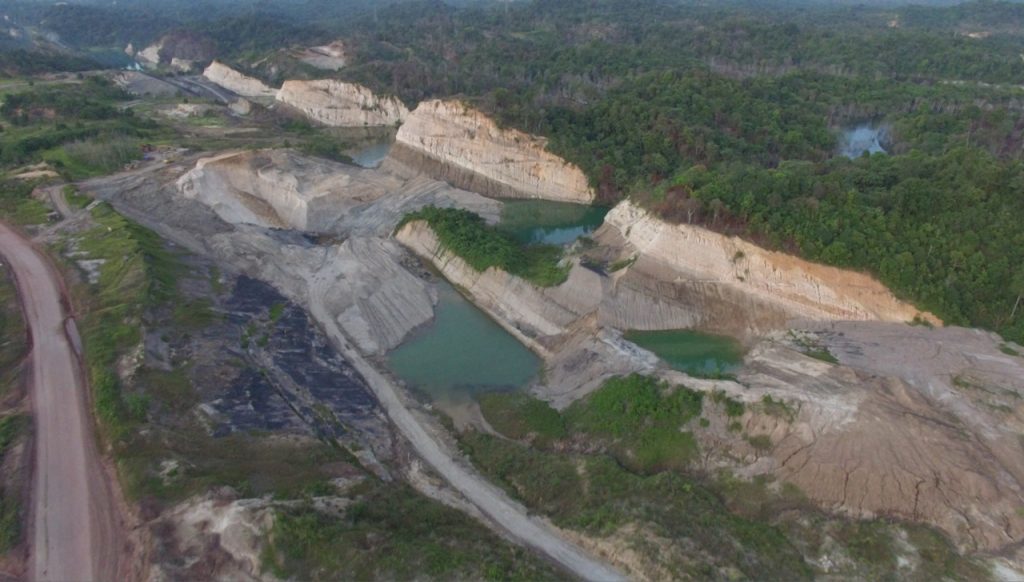
One of the hundreds abandoned mine coal pits in Northern Samarinda, East Kalimantan. Photo: Jatam Kaltim.
During the dry season, the water of the Mahakam River decreased and PDAM struggled to meet the demands of its customers. The water crisis reached other urban areas. People had no other option than to buy water from water tanks. PDAM saw this as an opportunity to double their profit. Around 1200 liters of water from PDAM water tank cost about 23 euro, while the same amount of water from other sources cost much less (about 5 euro). Though much more expensive, people still choose to buy PDAM water because they believe it is safer.
In the last seven years, the water gallons business has boomed in Samarinda. Every month, a household of 5-6 members needs about 25 gallons of water which cost around 15 euro. This equals to 19-30% of the monthly minimum living wages of the Samarinda.
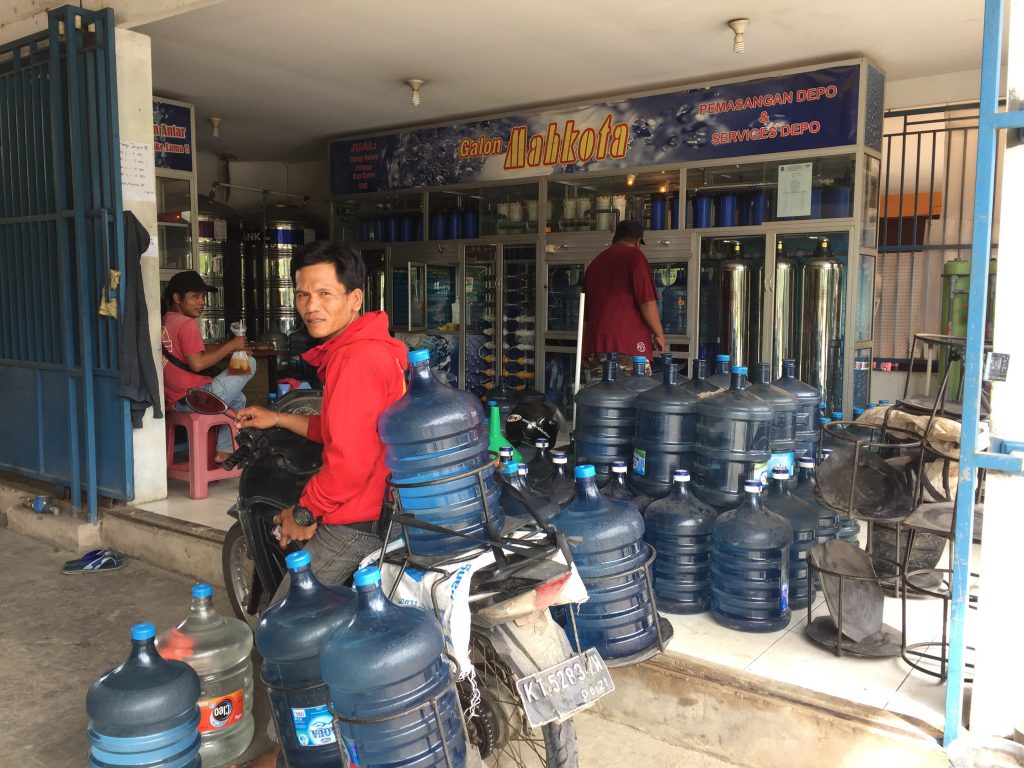
One of hundreds of the Refill drinking water stores in Samarinda. Photo: Sarah Agustiorini.
Reclaiming the commons
The story of privatization is not the only one about the Mahakam River. There are also other stories about the re-commoning of the river that need to be told. Samarinda people have long lived in deteriorating environments and were forced to adapt to the demands of the global market. People had to change the way they were experiencing their city as a living space including the imagination of what kind of transition is required to live side by side with the river, as a common.
Today, building on this historical experience, Samarinda citizens are actively organizing to improve their living conditions. The younger generations who are part of the East Kalimantan Mining Advocacy Network (JATAM) are fighting for their rights in light of the water crisis. They are asking the government to stop mining and closing the abandoned coal pits so that Samarinda can start addressing its social-ecological crisis. In 2011, the movement of Samarinda Menggugat submitted the first citizen lawsuit in Southeast Asia in relation to coal, flood, climate change, and the death of children in abandoned mine pits. The lawsuit was supported by different groups of people, including women, farmers, academics, students as well as religious groups.
In 2014, the citizens won the lawsuit in the District Court of Samarinda. Moreover, in 2016, the court denied the plea from the local and national government officials. The judge found the national and local governments guilty for not having supervised the mining permits. The government appealed a case to the Supreme Court. The Supreme Court had to fail the citizens’ lawsuit because it was not recognized by the Indonesian court system. This meant that the highest law institution in the country had cost the people of Samarinda. In 2016, a group of environmental activists formed a river supporting community and established the school of Karang Mumus river, recruiting volunteers to take care of the river. In the past three years, these volunteers have continuously cleaned the river and planted more than nine thousand trees to restore the river banks. Another youth group called “Aksi Kamisan” or “Thursday protest” organised weekly protests in front of the East Kalimantan governor office to remind the government of the unsolved human rights cases, corruption and environmental issues.
Reclaiming the living space of the commons is not an easy task. People need to unite and seize political support to protect the Mahakam river. The complexity of the problem shapes the predatory character of the city which serves the extractive industry while exploiting its residents and nature. It is important for the Samarinda citizens to be aware of the multiple privatisation processes that have taken place since the colonial era and that have forced people to become refugees in residual spaces.
—
Siti Maimunah is a PhD student and Marie Slodowska Curie Fellow at the University of Passau (Germany) in the “Well Being, Ecology, Gender and cOmmunity” (WEGO-ITN) project, who has received funding from the European Union’s Horizon 2020 research and innovation programme under the Marie Sklodowska-Curie grant agreement No. 764908. Her research focuses on processes of agrarian transformation and water governance in Maharashtra from a feminist perspective.
Sarah Agustiorini is an activist and researcher of a woman organisation called Tim Kerja Perempuan dan Tambang (TKPT) and of the local NGO JATAM East Kalimantan.
Cover image: Coal transported on the Mahakam river twenty four hours a day. Photo: Senny Jatam.


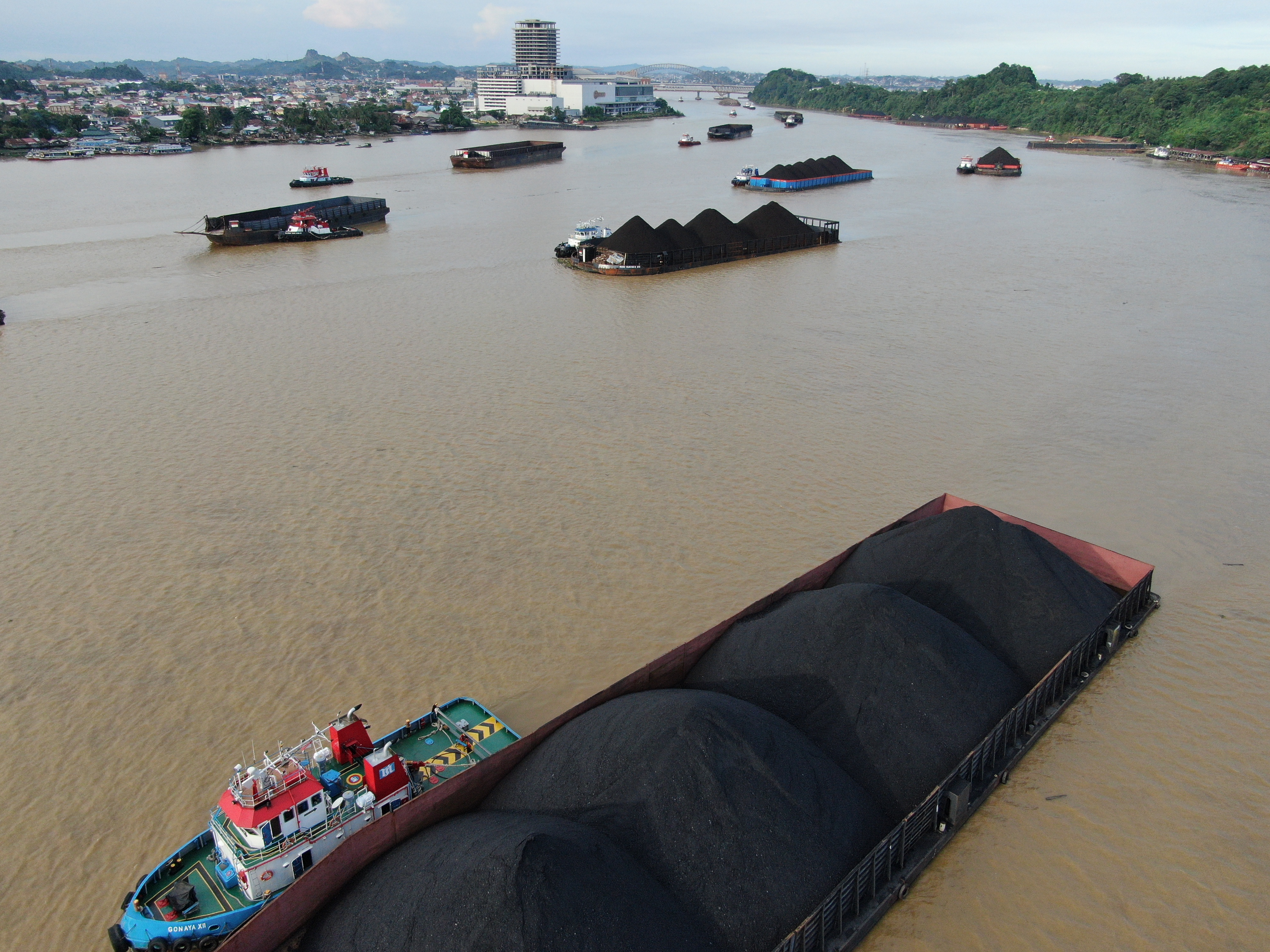

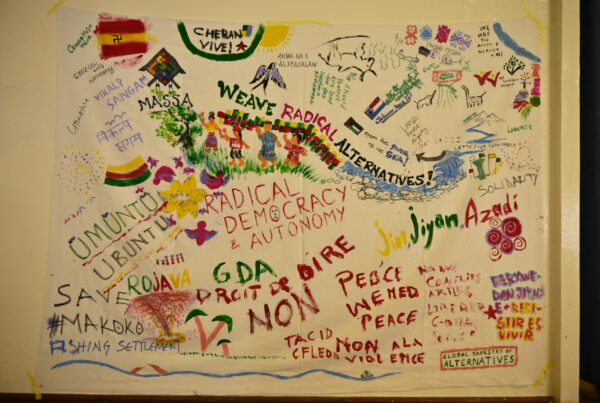
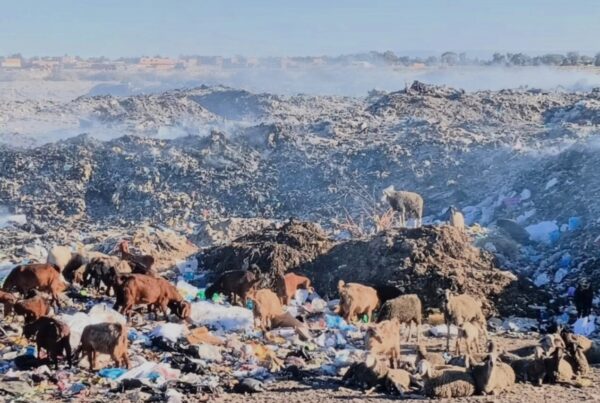
7 Comments